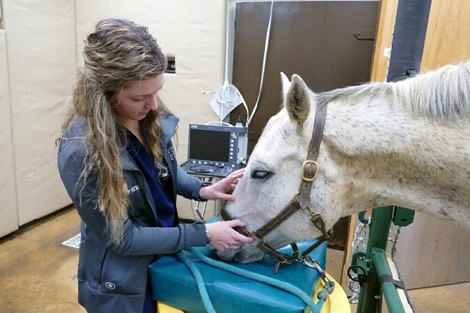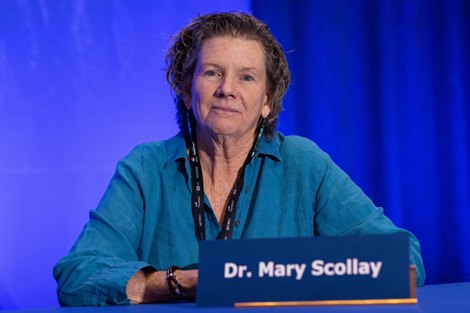The world of equine medicine is in crisis, and if action is not taken soon to correct course, the damage may be irreparable.
The number of equine veterinarians has been degenerating for years, leading to a shortage of skilled workers, the effects of which are being felt by the industry today.
David Foley, executive director of the American Association of Equine Practitioners (AAEP), said his organization noticed the downward trend about five or six years ago.
“For me, the best way to measure that is by membership,” he said. “It's been pretty flat for a few years. I mean, we have many, many members, fresh members join every year. And then we lose a smaller percentage. But then we also have an aging population of (our) members.” … And then we started really hearing about our practices. This caught our attention.
The factors contributing to the decline are convoluted. Other components beyond aging include education, compensation, and the need to be aware of the different career paths available.
Sign in Blood horse Daily
“The cost of education has just skyrocketed,” said Dr. Mary Scollay, Scientific Director of the Horseracing Integrity & Welfare Unit. “It is not uncommon for students to graduate with $300,000 or more in student loan debt between undergraduate and veterinary school. And what veterinarians earn after they graduate is a very daunting prospect, considering that you have to pay it off over decades.” makes it challenging for them to think about owning a practice; it makes it tough for them to think about owning a home.
Dr. Mary Scollay
According to U.S. News & World Report data, an in-state bachelor's degree costs $22,953 in 2022-23. Meanwhile, a 2020 Nerd Wallet report said a state doctorate in veterinary medicine costs up to $247,455. All told, a student could spend nearly $340,000.
Once you graduate and have to deal with debt, it becomes just as tough to find a work-life balance. When someone takes a job at a race track, their day begins before sunrise and can run until the end of the day or night race.
Scollay suggested industry stakeholders – tracks, racing commissions, racing associations and major breeders – find inventive ways to attract and retain fresh talent. One such method would be to subsidize a portion of the cost of education in exchange for x years of commitment.
Even if the industry could attract fresh talent, getting a younger generation to stay is another challenge.
Scollay said petite animal practices have long recognized the need for work-life balance. This sector has adopted measures such as four days off and three days off, but unlike their equine counterparts, petite animal veterinarians have emergency clinics.
AAEP's Foley said, “I think older practitioners who were used to working six, seven days a week have done just that, and the younger members are expecting more balance in their lives, and I really can't say “I'm wrong if I do that.”
The need to find solutions to the decline in equine veterinarians is fresh. Novel problems require fresh answers.
“Those of us who have been around a long time just have a certain mindset and don't really know how to adjust to maybe hiring two vets to do the work as one so that there's time for ourselves, so there's time for that “Take the kids to school, pick them up, go to ball games and don't feel like you have to choose between family and work,” Scollay said.
She added: “We need to stop referring to, 'Well, when I was youthful.' … This is no longer a marketable premise.”
Through surveys, the AAEP tried to find out where the vulnerabilities lay for the different demographics of its members. The results led the AAEP to establish a Commission on Equine Veterinary Sustainability last year. Within the committee, there were five subcommittees that focused on specific factors: compensation, emergency coverage, student outreach, internships, and practice culture.

A horse is examined at Marion duPont Scott Equine Medical Center
Foley said these efforts are already starting to produce results.
“It's certainly not something that's going to be fixed overnight, and we're seeing practices kind of adjust some of their models,” he said. “I heard from a racetrack practice that thanked us for our work and was able to successfully hire four fresh employees.”
Part of the fight, Foley says, is “mythenizing” information that the AAEP believes is either false or not as concise as possible.
For example, he said the American Veterinary Medical Association has published information showing starting equine salaries are about $56,000, while petite animal salaries are nearly double that at $110,000. Foley said what the AVMA didn't take into account was compensation for performing emergency work, which brings that figure closer to $89,000 for equine veterinarians.
He added that the AVMA data will be shared with veterinary schools and influence the perception of students looking to begin their careers. And many vet schools don't discuss the different career options that exist, especially for those who want to work with horses.
“A lot of my classmates don't do this, whatever it was, they went to vet school and said, 'This is what I'm going to do and nothing else.' And certainly I am one of them. I think the stronger candidates now are the ones who demonstrate a broader understanding of what the job really entails.
Calls to several top veterinary programs in the United States were not returned.
The AAEP has student chapters at many colleges and universities and encourages equine practitioners to meet with these students about how they can pursue successful careers. There are other programs like Amplify Horse Racing, which connects industry professionals with youthful adults interested in a career in Thoroughbred horse racing.
Scollay said one of her mentees, a high school sophomore, came to Keeneland from Tennessee and a practicing veterinarian offered her a job after completing her training.
The decline in the number of qualified veterinarians is noticeable at the racetrack.
“We're hearing from reports around the country, particularly at the racetracks, that they're really struggling, and you know, not just racetrack practitioners, but government vets, that they're really struggling to find workers. So we “We’re hearing that a lot more now than ever before,” Foley said.
Scollay was recently at a race track where there was one practicing veterinarian for the entire population of that location.
“I know a lot of my colleagues are tired,” Scollay said. “I know many of my colleagues are frustrated. I know they have really long days. (But) I won’t watch them go away.”
How can the tide be turned and younger people attracted to the profession?
“There is very little health insurance for animals, and therefore animal health care is typically a direct deductible from the owner,” Scollay said. “In order to adequately compensate someone who has completed an eight-year college degree, which is not all that different from a medical degree, where does the money come from without harming the pet owner or the pets? Because vets are certainly expected to love animals and do everything they do. “I can facilitate an animal, regardless of what it actually costs. And this has created pressure and enormous stress for many veterinarians who feel a responsibility to the animal.
Both Foley and Scollay said it was not too early to sound the alarm given the industry's concerns. Not too dissimilar to environmentalists raising concerns and recognizing the need for change before it becomes a doomsday scenario of no return.
“I think we're close to it. … But I think some leads are already there,” Scollay said.


